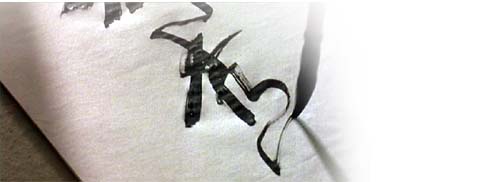|
More Essays | Chinese Songs | Chinese Riddles | Help | CantoDict | Links | Forums |
How to Write Chinese Characters |
|
Chinese characters are far more intricate than western letters of the alphabet; (It is worth noting however that each character contains meaning, whereas a western character is simply part of a word) and the complexity of the characters can be daunting at first. Take heart that it is definitely not as difficult as it first appears - after just a few lessons everyone in our class was writing the simpler characters with ease! The first thing to learn is the correct stroke order, a common mistake is to try and draw the characters. This is a serious error for several reasons:
Having said all this, I suppose I should explain the rules of writing! Strokes
Stroke Order
Stroke Order (advanced)
There is a great website that used animated pictures to show how you can write characters correctly at http://www.csulb.edu/~txie/azi/page1.htm. Another nice site is at http://www.ocrat.com/ although this one uses simplified characters only. Aesthetics and Proportions
 An example from a children's learning book
Top to bottom, left to right? A common question is "do Chinese people read top to bottom, right to left or left to right?" The quick answer is that if characters appear horizontally, they will be read left to right, in exactly the same was as English. If they are printed vertically, they are read top to bottom, starting from the right-most column and moving left. This means that vertically printed books will start from the "back", from the point of view of a Westerner, and each column of text will be read until the book finishes at the "front". Vertical text is common for shop signs and banners in general, and because each character is written inside an imaginary square, it looks just as pleasing to the eye as if it is written horizontally. One slight exception for horizontal text, is that short phrases will occasionally be written right to left for stylistic or historical effect. When watching period kung-fu films for example, the name on a temple is often written "backwards". Simplified or Traditional? For students who are trying to learn Chinese, the teaching method is the same whether they are learning Mandarin or Cantonese. Modern Mandarin characters are simplified, whereas Cantonese people from Hong Kong will use traditional forms, but the component strokes of both types of characters are the same. The popular view is that learning Traditional forms first, followed by Simplified ones is easier in the long run than doing the reverse. Simplified characters were not introduced until the mid twentieth century, so any Chinese art or literature before then will of course be written in Traditional script. Even in China today, designers or artists looking for a classical look will tend to use Traditional forms. By being aware of both, you increase your chances of being able to understand more Chinese. If you are getting put off by this talk of simplified and traditional characters, don't worry too much! Many characters are identical in both systems. For example, take a look at the Level 1 character list on this site and you will see that simplified forms only start appearing within the 8 stroke and above characters. Punctuation Modern Chinese uses punctuation in much the same way as other languages. There are a few minor differences though:
For more detail on punctuation, please see this interesting thread. There is also a thread about the question mark in Chinese. See also:
This is a work in progress, so if you have any suggestions, corrections or advice, please contact me or post in the Discussion Forum. |

|